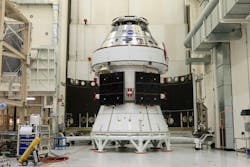Lockheed Martin hands over Artemis II Orion spacecraft to NASA ahead of 2026 lunar mission
DENVER - Lockheed Martin has completed assembly and testing of NASA’s Orion spacecraft for the Artemis II mission and officially transferred it to NASA’s Exploration Ground Systems team on May 1 for final launch preparations.
The milestone marks a key step in NASA’s Artemis program, which aims to return astronauts to the Moon and lay the groundwork for future human missions to Mars. Artemis II, currently scheduled for launch in early 2026, will be the first crewed flight of the Orion spacecraft and the first human mission to the Moon since Apollo 17 in 1972.
"This achievement is a testament to our employees and suppliers who have worked tirelessly to get us to this important milestone," said Kirk Shireman, vice president of Human Space Exploration and Orion program manager at Lockheed Martin. "It’s exciting to think that soon, humans will see the Earth rise over the lunar horizon from our vehicle."
Upgrades
The Artemis II Orion spacecraft includes major upgrades from earlier test flights, with new systems to support crew health and safety, such as life support, thermal control, waste management, audio communications, and an exercise machine. It also features a functional launch abort system, partial docking sensors, and an experimental laser communications system for high-data-rate transmissions.
NASA provides update on Artemis missions, heat shield investigation findings
With possession transferred, NASA’s team at Kennedy Space Center will complete spacecraft processing, including loading propellants, installing the launch abort fairing, and stacking the vehicle atop the Space Launch System rocket inside the Vehicle Assembly Building.
Lockheed Martin continues to build Orion spacecraft for future Artemis missions, with vehicles for Artemis III and IV already under assembly. The company holds a contract with NASA through Artemis VIII and reports cost reductions with each successive spacecraft.
About the Author
Jamie Whitney
Senior Editor
Jamie Whitney joined the staff of Military & Aerospace Electronics in 2018 and oversees editorial content and produces news and features for Military & Aerospace Electronics, attends industry events, produces Webcasts, and oversees print production of Military & Aerospace Electronics.
